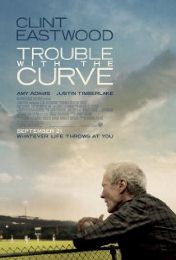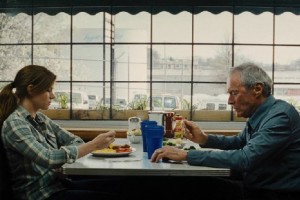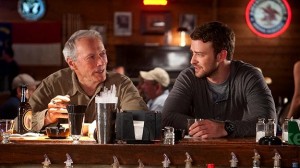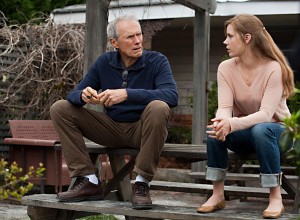THE AMERICAN PAST TIME
Driving to a screening of Trouble with the Curve last week, I was struck by how different my childhood must be from that of today’s children. It was a cool late summer evening. Children should be running through the front yards of the neighborhood. Where were the children playing ball? There were none.
There is an early scene in this Clint Eastwood-Amy Adams father-daughter baseball melodrama where children are in a meadow playing baseball. Kids with rosy cheeks chase fly balls through a Norman Rockwell moment. It seems so out of place with today. Trouble is a film grounded in the comforting nostrums of a gentler yesteryear. The film seems to be dealing out an America that no longer exists.
Trouble with the Curve is filled with old things: Old men; Old plot; Old style. Old cars (Clint’s 1967 Mustang, in an abusive relationship with the garage door); and Old routines (Clint’s trademark low growl).
The story itself is old-fashioned and sentimental. A professional baseball scout is losing his eyesight. He’s assigned to follow a young hotshot for a week to determine whether to sign him. His semi-estranged daughter, a high-powered lawyer (Amy Adams), tears away from an important case to help him on the road. Traveling the peaceful backroads of the Carolinas, it feels a world away from the troubled America of the moment.
Even its sappy melodramas seem like yesterday’s sappy melodramas. Can the old scout outdo his younger computerized competitors with his savvy and experience? Can the daughter make partner at her law firm against the cartoonishly evil boys club at the top? Can she lower her guard enough to find love with a fellow scout (Justin Timberlake)? Can father and daughter finally connect over their love of baseball? Its problems seem small compared to the things that are common today.
The actors are too warm to entirely dislike Trouble With the Curve. Between Eastwood, Adams, and Timberlake, there’s star charisma to burn. Adams and Eastwood have one particularly moving moment, as they take an empty high school field for a father-daughter at-bat. It’s that moment where director Robert Lorenz captures something timeless, the sort of timelessness that baseball holds spiritually.
For modern movies, the small-town South serves as a refuge of Americana. An antidote to the urbane city life. No one seems to notice that that world has changed, as well. But does anyone in Hollywood realize the demographics of these towns? Do they realize the enormous debates about bilingual education in Georgia? There is little attention paid to this new America until a Latino youngster brings a little diversity to the end. It’s that world that is emerging, and the world of Trouble with the Curve that’s coming to a close.
photos courtesy of Warner Bros.
Trouble with the Curve
Malpaso Productions & Warner Bros.
PG-13
wide release on September 21, 2012





{ 1 comment… read it below or add one }
You can only direct from what you know and, as far as one can imagine, it still comes from what one has learned to know. Clint Eastwood is a product of what he knows whether its wrapped in a cowboy hat or a plaid shirt; ultimately, its the same. It’s a shame because I am wondering the same about myself: Am I buying into what makes me feel comfortable with my repetitive personality and its gratification? Baseball is a metaphysical game in the sense that to perform it, one must leave his whole conditional being and exist in a nether world only unto himself. Make a movie about that.